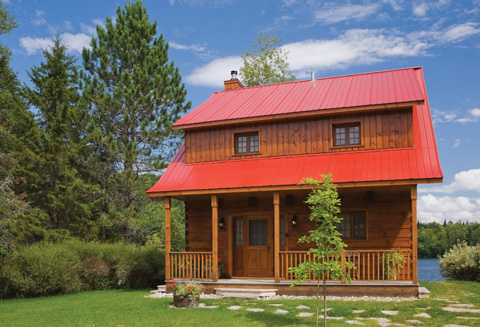Childhood memories often play a big role in one’s adult life. For Sylvie Gagnon-Sciortino, the summer vacations she spent at her grandparents place on the shore of a lake in the Lac Supérior region of the Laurentian Mountains in Quebec were just magical. It was a haven of peace, she recalls with emotion. So it is not surprising she would choose to build her small (27-by-24-foot) log cabin in this enchanted location, especially since her family still owns the land and her parents are her nearest neighbors. But it took another member of her family to finally persuade her to go ahead with the project. “My son told me, ‘Mom, it will be a great experience and I am sure you can do it,’“ says Sylvie. And, indeed, she did it all by herself, which gives her great pride. “It was a terrific experience and, if I had known how much fun it would be, I would have done it much sooner,“ she admits with amusement.
The project was indeed fun but it also meant making a lot of decisions. The first step was the choice of the log home supplier. After looking at several companies, Sylvie opted for Les Maisons Bondu Log Homes Inc., also located in the Laurentians, and for which she has only praise to share. The company has been in business for more than 40 years and specializes in producing milled log cabin kits. As Mathieu Bondu, the president, explains, milled logs have a great advantage. “Because the wood is dried for two years in the outdoors, there is no shrinkage once the house is built.“ Another advantage is the possibility of adding insulation material between the outer and inner walls.
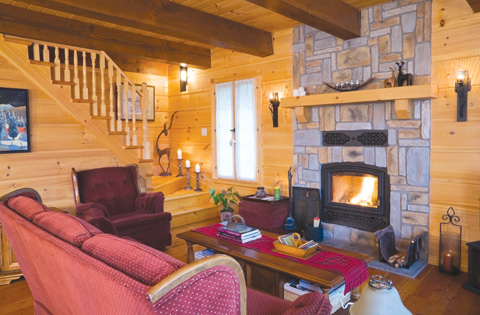
After selecting one of the company’s models, Sylvie sat down with one of their technicians to design the interior. Then, since the cabin is delivered as a kit, she had to find a building contractor and other subcontractors to install the plumbing, electrical systems, etc. Though she owns and operates a building company herself in Montreal, she chose to employ local people.
The cabin was built using a technique called pièce sur pièce (piece on piece), with milled logs having a rectangular profile and dovetailed ends. The wood is knotty Eastern Quebec white pine and is also locally sourced. The insulation is composed of several layers, including urethane panels and stone wool (Roxul), which has excellent thermal properties as well as being fire resistant. “In summer, the house stays nice and cool. And in winter, even if I don’t come up for two weeks, the interior never feels cold,” declares Sylvie. “It’s really great.”
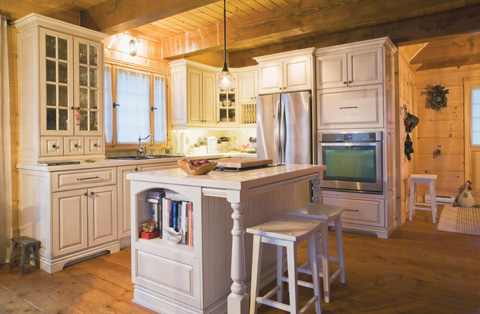
The wood-burning stove in the living room is all she needs most of the time to keep the whole cabin warm. Electricity is the other source of heat when needed. Set in natural stones of various shapes and colors, the stove is the focal point of the cozy living room, which happens to be Sylvie’s favorite room. Contrasting with the pale shade of the walls, the beams supporting the second story are carved out of Douglas fir from British Columbia; Sylvie chose the same sturdy wood for the floor.
For the kitchen, Sylvie relied on the services of a professional designer as it involved quite a few technical details to work out. With the ground floor being an open area, painting the kitchen cabinets white was a clever way to make this corner of the cabin stand out. In keeping with the country theme, Sylvie opted for ceramic tiles for the counter and island tops instead of the usual granite. Abundant daylight from two large windows illuminates the dining area. The custom-made dining set may be new but it has a rustic look that fits perfectly in the décor.
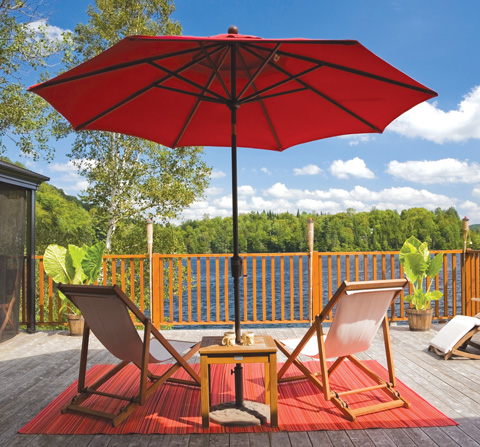
Two bedrooms and a bathroom occupy the second floor. French doors open up to reveal the master bedroom, and with space being at a premium, there is just enough room for a queen-size bed, an armchair, and an antique commode that once belonged to Sylvie’s grandmother. Guests are surely delighted with their bedroom, just as sparsely furnished and decorated as the main one so as not to distract from the warmth of the lovely blond-colored wood.
Also on the upstairs floor, a litt
le mezzanine is fitted with a sleeper sofa for extra guests to spend a night or two. Sylvie didn’t stray from the country chic theme in the main bathroom, choosing fixtures and decorations accordingly. The free-standing bathtub is raised on elegant cast iron legs and the large shower stall is lined with ceramic tiles in earth tones, both purchased from local companies. In that regard, it can be said that Sylvie has a near perfect record of supporting the local economy.
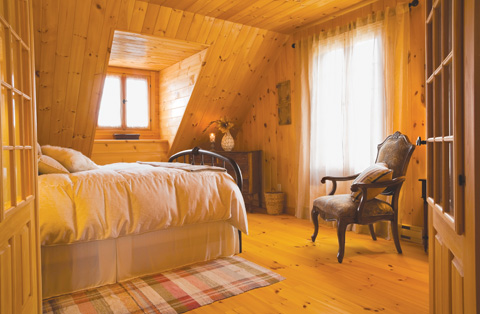
Being close to the water’s edge, she needed a wastewater treatment system that would comply with the environmental regulations set forth by the Quebec Ministry of the Environment. She selected Bionest, a Quebec-based company that manufactures compact and efficient septic systems that are suited to all types of soil and terrain. The cabin is also equipped with a water purification system as the drinking water must be pumped up to the cabin from the lake.
Having a lakeside property is a privilege to be savored and enjoyed, and Sylvie initially had planned to build steps going down to the water’s edge, but her children suggested a deck instead and she is grateful for their advice. It feels so good to lounge on the wooden deck, which is as long as the cabin and overlooks the lake, surrounded by a beautiful environment. It’s great for entertaining too, she declares.
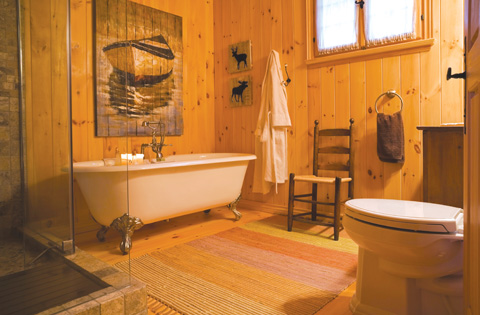
Like in her youth when she would spend her summer vacations at her grandparents’ place, her little log cabin has become a haven of peace and tranquility for her, a place where she can come to relax and unwind, and in a few years’ time, a place to spend her retirement.
Sylvie is absolutely thrilled and in love with her weekend retreat and gushes with enthusiasm when talking about it, even calling it “a bundle of happiness.” She is also very proud of the fact her cabin is featured in a recently published coffee table book, Log Homes of Québec by Perry Mastrovito, whose photos and features regularly appear in this magazine.

